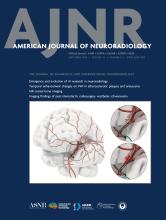Index by author
Prayer, Daniela
- Pediatric NeuroimagingOpen AccessSynthetic MRI and MR Fingerprinting–Derived Relaxometry of Antenatal Human Brainstem Myelination: A Postmortem-Based Quantitative Imaging StudyVictor U. Schmidbauer, Intesar-Victoria Malla Houech, Jakob Malik, Martin L. Watzenboeck, Rebecca Mittermaier, Patric Kienast, Christina Haberl, Ivana Pogledic, Christian Mitter, Gregor O. Dovjak, Astrid Krauskopf, Florian Prayer, Marlene Stuempflen, Tim Dorittke, Nikolai A. Gantner, Julia Binder, Dieter Bettelheim, Herbert Kiss, Christine Haberler, Ellen Gelpi, Daniela Prayer and Gregor KasprianAmerican Journal of Neuroradiology September 2024, 45 (9) 1327-1334; DOI: https://doi.org/10.3174/ajnr.A8337
Prayer, Florian
- Pediatric NeuroimagingOpen AccessSynthetic MRI and MR Fingerprinting–Derived Relaxometry of Antenatal Human Brainstem Myelination: A Postmortem-Based Quantitative Imaging StudyVictor U. Schmidbauer, Intesar-Victoria Malla Houech, Jakob Malik, Martin L. Watzenboeck, Rebecca Mittermaier, Patric Kienast, Christina Haberl, Ivana Pogledic, Christian Mitter, Gregor O. Dovjak, Astrid Krauskopf, Florian Prayer, Marlene Stuempflen, Tim Dorittke, Nikolai A. Gantner, Julia Binder, Dieter Bettelheim, Herbert Kiss, Christine Haberler, Ellen Gelpi, Daniela Prayer and Gregor KasprianAmerican Journal of Neuroradiology September 2024, 45 (9) 1327-1334; DOI: https://doi.org/10.3174/ajnr.A8337
Puig, Josep
- Brain Tumor ImagingYou have accessSex-Specific Differences in Patients with IDH1–Wild-Type Grade 4 Glioma in the ReSPOND ConsortiumSree Gongala, Jose A. Garcia, Nisha Korakavi, Nirav Patil, Hamed Akbari, Andrew Sloan, Jill S. Barnholtz-Sloan, Jessie Sun, Brent Griffith, Laila M. Poisson, Thomas C. Booth, Rajan Jain, Suyash Mohan, MacLean P. Nasralla, Spyridon Bakas, Charit Tippareddy, Josep Puig, Joshua D. Palmer, Wenyin Shi, Rivka R. Colen, Aristeidis Sotiras, Sung Soo Ahn, Yae Won Park, Christos Davatzikos, Chaitra Badve and on behalf of the ReSPOND ConsortiumAmerican Journal of Neuroradiology September 2024, 45 (9) 1299-1307; DOI: https://doi.org/10.3174/ajnr.A8319
Pulli, Benjamin
- NeurointerventionYou have accessDual-Energy CTA Iodine Map Reconstructions Improve Visualization of Residual Cerebral Aneurysms following Endovascular CoilingDylan N. Wolman, Gabriella Kuraitis, Eric Sussman, Benjamin Pulli, Anke Wouters, Jia Wang, Adam Wang, Maarten G. Lansberg and Jeremy J. HeitAmerican Journal of Neuroradiology September 2024, 45 (9) 1220-1226; DOI: https://doi.org/10.3174/ajnr.A8305
Qu, Hang
- Artificial IntelligenceYou have accessIntegrating Clinical Data and Radiomics and Deep Learning Features for End-to-End Delayed Cerebral Ischemia Prediction on Noncontrast CTQi-qi Ban, Hao-tian Zhang, Wei Wang, Yi-fan Du, Yi Zhao, Ai-jun Peng and Hang QuAmerican Journal of Neuroradiology September 2024, 45 (9) 1260-1268; DOI: https://doi.org/10.3174/ajnr.A8301
Quinones-hinojosa, Alfredo
- FELLOWS' JOURNAL CLUBUltra-High-Field MRI/Imaging of Epilepsy/Demyelinating Diseases/Inflammation/InfectionYou have accessRadiologic Classification of Hippocampal Sclerosis in EpilepsyErik H. Middlebrooks, Vivek Gupta, Amit K. Agarwal, Brin E. Freund, Steven A. Messina, William O. Tatum, David S. Sabsevitz, Anteneh M. Feyissa, Seyed M. Mirsattari, Fernando N. Galan, Alfredo Quinones-Hinojosa, Sanjeet S. Grewal and John V. MurrayAmerican Journal of Neuroradiology September 2024, 45 (9) 1185-1193; DOI: https://doi.org/10.3174/ajnr.A8214
This review explores how the International League Against Epilepsy (ILAE) subtypes of hippocampal sclerosis correlate with MRI findings. Hippocampal anatomy is reviewed in detail. The pathophysiology of hippocampal sclerosis is discussed. A radiologic classification scheme is proposed that aligns with the ILAE pathology classification, aiming to improve clinical communication and decision-making.
Raghavan, Prashant
- Artificial IntelligenceYou have accessAssessing the Performance of Artificial Intelligence Models: Insights from the American Society of Functional Neuroradiology Artificial Intelligence CompetitionBin Jiang, Burak B. Ozkara, Guangming Zhu, Derek Boothroyd, Jason W. Allen, Daniel P. Barboriak, Peter Chang, Cynthia Chan, Ruchir Chaudhari, Hui Chen, Anjeza Chukus, Victoria Ding, David Douglas, Christopher G. Filippi, Adam E. Flanders, Ryan Godwin, Syed Hashmi, Christopher Hess, Kevin Hsu, Yvonne W. Lui, Joseph A. Maldjian, Patrik Michel, Sahil S. Nalawade, Vishal Patel, Prashant Raghavan, Haris I. Sair, Jody Tanabe, Kirk Welker, Christopher T. Whitlow, Greg Zaharchuk and Max WintermarkAmerican Journal of Neuroradiology September 2024, 45 (9) 1276-1283; DOI: https://doi.org/10.3174/ajnr.A8317
Ran, Qi-Sheng
- NeurointerventionYou have accessMCA Parallel Anatomic Scanning MR Imaging–Guided Recanalization of a Chronic Occluded MCA by Endovascular TreatmentCheng-Chun Liu, Yi Yang, Jun Dong, Zhi-Qiang Sun, Qi-Sheng Ran, Wei Li, Wang-Sheng Jin and Meng ZhangAmerican Journal of Neuroradiology September 2024, 45 (9) 1227-1229; DOI: https://doi.org/10.3174/ajnr.A8303
Rathore, Saima
- Artificial IntelligenceYou have accessImpact of SUSAN Denoising and ComBat Harmonization on Machine Learning Model Performance for Malignant Brain NeoplasmsGirish Bathla, Neetu Soni, Ian T. Mark, Yanan Liu, Nicholas B. Larson, Blake A. Kassmeyer, Suyash Mohan, John C. Benson, Saima Rathore and Amit K. AgarwalAmerican Journal of Neuroradiology September 2024, 45 (9) 1291-1298; DOI: https://doi.org/10.3174/ajnr.A8280
Rauch, Steven D.
- EDITOR'S CHOICEHead and Neck ImagingYou have accessRetrolabyrinthine Bone Thickness as a Radiologic Marker for the Hypoplastic Endotype in Menière DiseaseAmy F. Juliano, Kuei-You Lin, Nitesh Shekhrajka, Donghoon Shin, Steven D. Rauch and Andreas H. EckhardAmerican Journal of Neuroradiology September 2024, 45 (9) 1363-1369; DOI: https://doi.org/10.3174/ajnr.A8339
There are 2 major endotypes of Menière disease: one with a hypoplastic, underdeveloped endolymphatic sac and one with a normally developed sac that degenerates over time. This study explored the link between angular trajectory of the vestibular aqueduct and the thickness of the retrolabyrinthine bone to provide differentiation between MD endotypes using CT and MRI. The average retrolabyrinthine bone thickness was statistically significantly different between endotypes with retrolabyrinthine bone thickness >=1.2 mm, effectively ruling out hypoplastic Menière disease.








